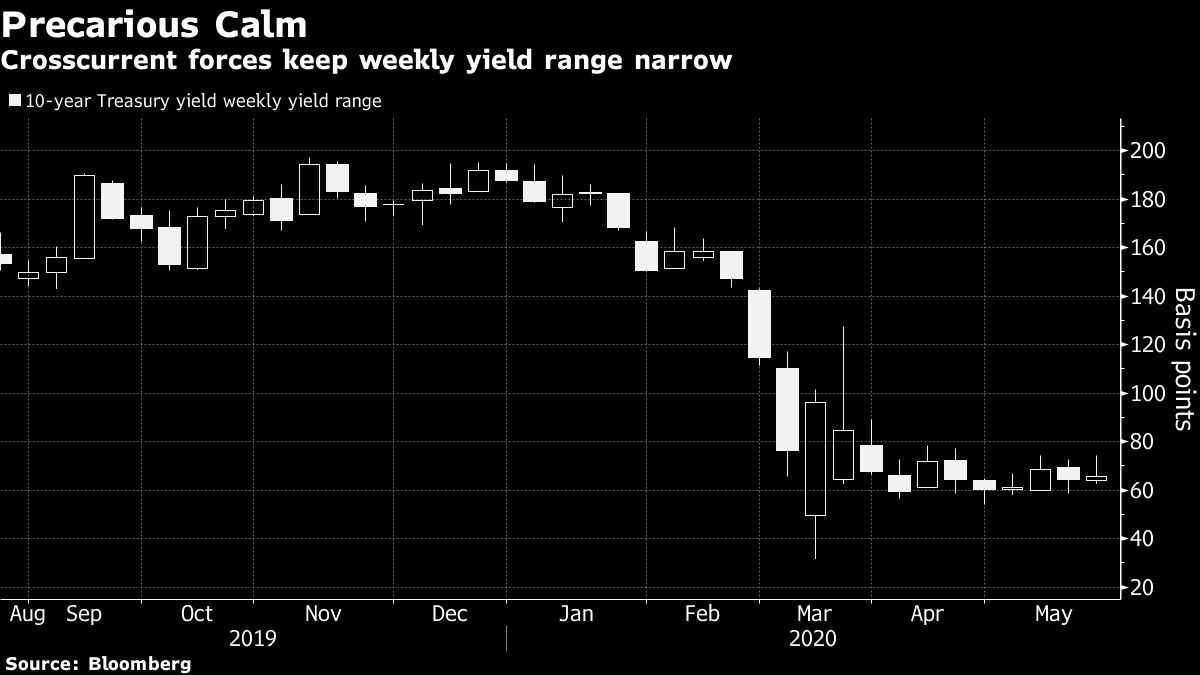May 24, 2020
U.S.-China tensions hammerlock bond market hopeful on reopenings
, Bloomberg News
'You can't hide in bonds' amid COVID-19: AGF CEO
The Treasury market is holding in a tenuous calm as traders balance fears that U.S.-China tensions will escalate with hopes that the tepid pace of American business reopenings pick up steam.
The rift between Washington and Beijing has moved beyond issues related to the pandemic to include angst over China’s national security actions against Hong Kong. This backrop has crimped investors’ risk appetite and bolstered demand for Treasuries as a haven. Still, bond bears aren’t giving up, emboldened by the easing of social-distancing measures across many U.S. states and by the pipeline of Treasury supply that is growing larger.
Ten-year Treasury yields have swung in a range of only about 24 basis points since the start of April, after chaos in March when concern over the pandemic was at its peak. The ICE BofA MOVE Index, an options-based gauge of implied volatility in Treasuries, is at a level that is about one-third the almost 11-year high reached on March 9. This precarious calm may get a jolt as Federal Reserve speakers including Chairman Jerome Powell take part in a virtual panel discussion on the final day of the holiday-shortened week.
“U.S.-China relations seem to be coming to the boil and that situation continues to influence trading, pressuring yields lower,” said Marty Mitchell, an independent strategist. “Offsetting that is optimism related to the reopening of the economy and that the spread of the virus hasn’t had much of a resurgence. It leaves Treasuries in a a sideways, stubborn, range.”

Ten-year yields hover at about 0.66 per cent, after swinging between a low of 0.54 per cent and high of 0.78 per cent since the beginning of April. The benchmark long-term borrowing rate moved four times that span in March. Amid the calm, the gap between 2- and 10-year yields has stabilized at about 49 basis points.
The market has to digest another round of Treasury supply in the coming week, though it gets a respite from a recent dose that was tilted toward longer maturities. Only bills and notes that come due within seven years will be auctioned. That should bias the curve flatter, with strategists also seeing long-term debt supported by month-end portfolio rebalancing effects given that key bond indexes are predicted to have a large extension.
Treasury issuance has ballooned due to fiscal support to combat the effect of the coronavirus pandemic on growth. And with Treasury Secretary Steven Mnuchin predicting Congress will need to do more, some foresee bond market tranquility eventually ending.
“The unprecedented amount of fiscal stimulus being implemented should lead to a rebound in rate volatility over the longer term,” Subadra Rajappa, head of U.S. rates strategy at Societe Generale, said in a note.
What to Watch
• U.S. markets are closed Monday in observance of Memorial Day
• The economic calendar:
-May 26: Chicago Fed national activity; house price purchase index; FHFA house price index; S&P CoreLogic home price data; Conference Board consumer confidence and expectations; new home sales; Dallas Fed manufacturing activity
-May 27: MBA mortgage applications; Richmond Fed manufacturing activity; Fed’s Beige Book
-May 28: Second reading of first-quarter GDP; personal consumption; durable/capital goods; jobless claims; Bloomberg consumer comfort; pending home sales; Kansas City Fed manufacturing activity
-May 29: Advance goods trade balance; retail inventories; personal income/spending; personal consumption expenditures deflator data; MNI Chicago PMI; University of Michigan sentiment/current conditions/expectations
• Powell is the highlight of Fed speakers:
-May 26: Minneapolis Fed’s Neel Kashkari
-May 27: St. Louis Fed’s James Bullard; Atlanta Fed President Raphael Bostic
-May 28: New York Fed’s John Williams; Philadelphia Fed’s Patrick Harker
-May 29: Fed Chair Powell in virtual discussion with former Fed Vice Chairman Alan Blinder
• Here’s the schedule of Treasury auctions:
-May 26: US$63 billion 13-week, US$54 billion 26-week bills, and US$65 billion 42-day cash management bills; US$44 billion 2-year notes
-May 27: US$40 billion 119-day cash management bills and US$25 billion 273-day cash management bills; US$20 billion 2-year floating-rate notes; US$45-billion 5-year notes
-May 28: 4-week and 8-week bills; US$38 billion 7-year notes








